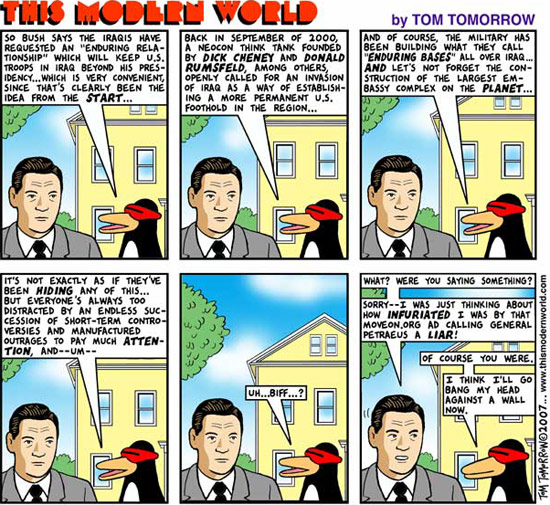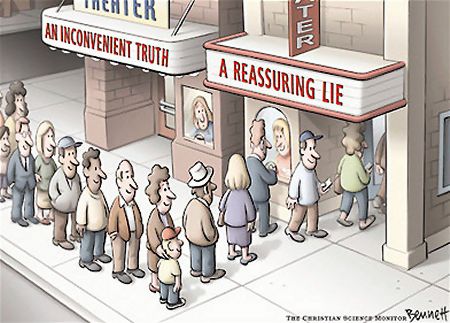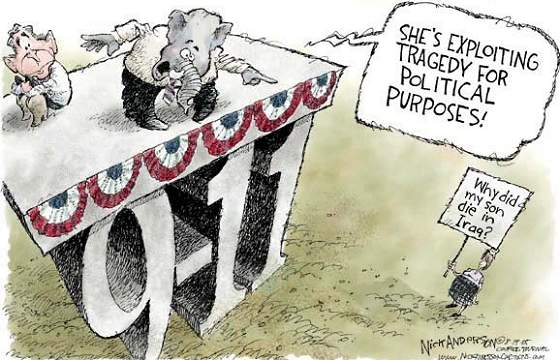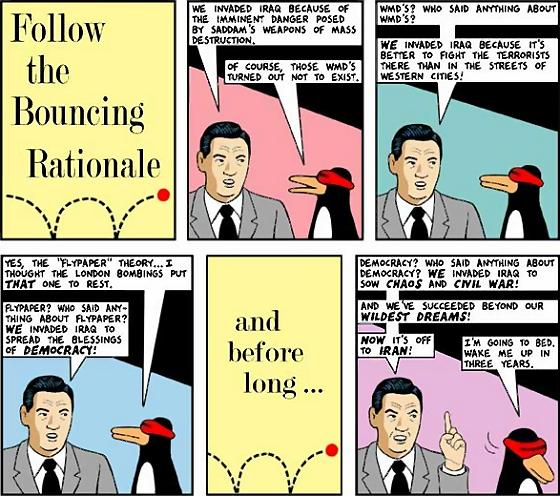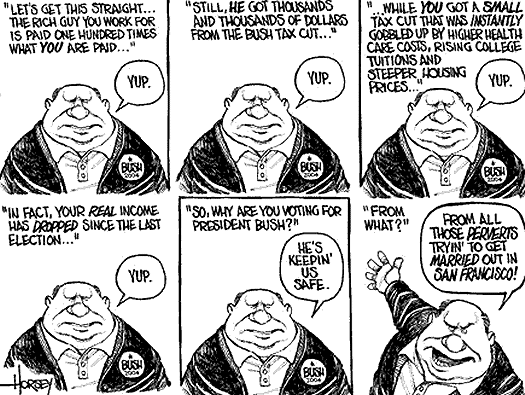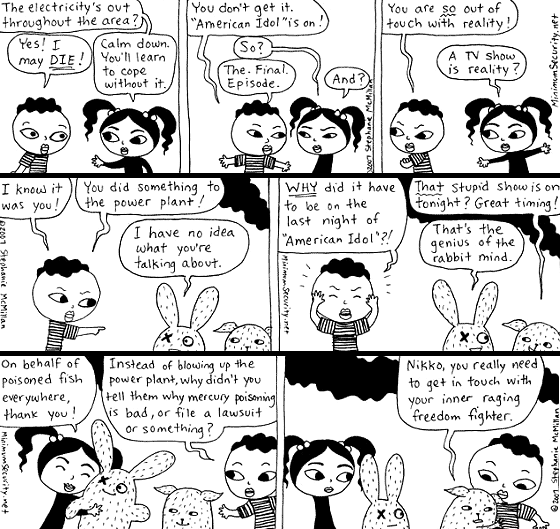= = = = = = = = = = = = = = = < B e l o w T h e F o l d > = = = = = = = = = = = = = = =
This article appears in The New Republic Online's site, linked here.
How Economic Crackpots Devoured American Politics.
Feast of the Wingnuts
by Jonathan Chait
American politics has been hijacked by a tiny coterie of right-wing economic extremists, some of them ideological zealots, others merely greedy, a few of them possibly insane. The scope of their triumph is breathtaking. Over the course of the last three decades, they have moved from the right-wing fringe to the commanding heights of the national agenda. Notions that would have been laughed at a generation ago--that cutting taxes for the very rich is the best response to any and every economic circumstance or that it is perfectly appropriate to turn the most rapacious and self-interested elements of the business lobby into essentially an arm of the federal government--are now so pervasive, they barely attract any notice.
The result has been a slow- motion disaster. Income inequality has approached levels normally associated with Third World oligarchies, not healthy Western democracies. The federal government has grown so encrusted with business lobbyists that it can no longer meet the great public challenges of our time. Not even many conservative voters or intellectuals find the result congenial. Government is no smaller--it is simply more debt-ridden and more beholden to wealthy elites.
It was not always this way. A generation ago, Republican economics was relentlessly sober. Republicans concerned themselves with such ills as deficits, inflation, and excessive spending. They did not care very much about cutting taxes, and (as in the case of such GOP presidents as Herbert Hoover and Gerald Ford) they were quite willing to raise taxes in order to balance the budget. While many of them were wealthy and close | | 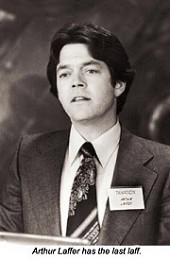 |
| to business, the leaders of business themselves had a strong sense of social responsibility that transcended their class interests. By temperament, such men were cautious rather than utopian. |
Over the last three decades, however, such Republicans have passed almost completely from the scene, at least in Washington, to be replaced by, essentially, a cult.
All sects have their founding myths, many of them involving circumstances quite mundane. The cult in question generally traces its political origins to a meeting in Washington in late 1974 between Arthur Laffer, an economist; Jude Wanniski, an editorial page writer for The Wall Street Journal; and Dick Cheney, then deputy assistant to President Ford. Wanniski, an eccentric and highly excitable man, had until the previous few years no training in economics whatsoever, but he had taken Laffer’s tutelage.
His choice of mentor was certainly unconventional. Laffer had been on the economics faculty at the University of Chicago since 1967. In 1970, his mentor, George Shultz, brought him to Washington to serve as a staffer in the Office of Management and Budget. Laffer quickly suffered a bout with infamy when he made a wildly unconventional calculation about the size of the 1971 Gross National Product, which was far more optimistic than estimates elsewhere. When it was discovered that Laffer had used just four indicators to arrive at his figure--most economists used hundreds if not thousands of inputs--he became a Washington laughingstock. Indeed, he turned out to be horribly wrong. Laffer left the government in disgrace and faced the scorn of his former academic colleagues yet stayed in touch with Wanniski, whom he had met in Washington, and continued to tutor him in economics.
Starting in 1972, Wanniski came to believe that Laffer had developed a blinding new insight that turned established economic wisdom on its head. Wanniski and Laffer believed it was possible to simultaneously expand the economy and tamp down inflation by cutting taxes, especially the high tax rates faced by upper-income earners. Respectable economists-- not least among them conservative ones--considered this laughable. Wanniski, though, was ever more certain of its truth. He promoted this radical new doctrine through his perch on The Wall Street Journal editorial page and in a major article for The Public Interest, a journal published by the neoconservative godfather Irving Kristol. Yet Wanniski’s new doctrine, later to be called supply-side economics, had failed to win much of a following beyond a tiny circle of adherents.
That fateful night, Wanniski and Laffer were laboring with little success to explain the new theory to Cheney. Laffer pulled out a cocktail napkin and drew a parabola-shaped curve on it. The premise of the curve was simple. If the government sets a tax rate of zero, it will receive no revenue. And, if the government sets a tax rate of 100 percent, the government will also receive zero tax revenue, since nobody will have any reason to earn any income. Between these two points--zero taxes and zero revenue, 100 percent taxes and zero revenue--Laffer’s curve drew an arc. The arc suggested that at higher levels of taxation, reducing the tax rate would produce more revenue for the government.
At that moment, there were a few points that Cheney might have made in response. First, he could have noted that the Laffer Curve was not, strictly speaking, correct. Yes, a zero tax rate would obviously produce zero revenue, but the assumption that a 100-percent tax rate would also produce zero revenue was, just as obviously, false. Surely Cheney was familiar with communist states such as the Soviet Union, with its 100 percent tax rate. The Soviet revenue scheme may not have represented the cutting edge in economic efficiency, but it nonetheless managed to collect enough revenue to maintain an enormous military, enslave Eastern Europe, fund ambitious projects such as Sputnik, and so on. Second, Cheney could have pointed out that, even if the Laffer Curve was correct in theory, there was no evidence that the U.S. income tax was on the downward slope of the curve--that is, that rates were then high enough that tax cuts would produce higher revenue.
But Cheney did not say either of these things. Perhaps, in retrospect, this was due to something deep in Cheney’s character that makes him unusually susceptible to theories or purported data that confirm his own ideological predilections. (You can almost picture Donald Rumsfeld, years later, scrawling a diagram for Cheney on a cocktail napkin showing that only a small number of troops would be needed to occupy Iraq.) In any event, Cheney apparently found the Laffer Curve a revelation, for it presented in a simple, easily digestible form the messianic power of tax cuts.
The significance of the evening was not the conversion of Cheney but the creation of a powerful symbol that could spread the word of supply-side economics. If you try to discuss economic theory with most politicians, their eyes will glaze over. But the Curve explained it all. There in that sloping parabola was the magical promise of that elusive politician’s nirvana, a cost-free path to prosperity: lower taxes, higher revenues. It was beautiful, irresistible.
With astonishing speed, the message of the Laffer Curve spread through the ranks of conservatives and Republicans. Wanniski evangelized tirelessly on behalf of this new doctrine, both on the Journal’s editorial pages and in person. As an example of the latter, one day in 1976, he wandered by the office of a young representative named Jack Kemp. He asked to talk to Kemp for 15 minutes, but he wound up expounding on the supply-side gospel to the former NFL quarterback for the rest of the day, through dinner, and late into the night. “He took to it like a blotter,” Wanniski later recalled. “I was exhausted and ecstatic. I had finally found an elected representative of the people who was as fanatical as I was.”
Adherents of supply-side economics tend to describe the spread of their creed in quasi-religious terms. Irving Kristol subsequently wrote in a memoir, “It was Jude [Wanniski] who introduced me to Jack Kemp, a young congressman and a recent convert. It was Jack Kemp who, almost single-handed, converted Ronald Reagan to supply-side economics.” The theological language is fitting because supply-side economics is not merely an economic program. It’s a totalistic ideology. The core principle is that economic performance hinges almost entirely on how much incentive investors and entrepreneurs have to attain more wealth, and this incentive in turn hinges almost entirely on their tax rate. Therefore, cutting taxes-- especially those of the rich, who carry out the decisive entrepreneurial role in the economy--is always a good idea.
But what, you may ask, about deficits, the old Republican bugaboo? Supply-siders argue either that tax cuts will produce enough growth to wipe out deficits or that deficits simply don’t matter. When Reagan first adopted supply-side economics, even many Republicans considered it lunacy. (“Voodoo economics,” George H. W. Bush famously called it.) Today, though, the core beliefs of the supply-siders are not even subject to question among Republicans. Every major conservative opinion outlet promotes supply-side economics. Since Bush’s heresy of acceding to a small tax hike in 1990, deviation from the supply-side creed has become unthinkable for any Republican with national aspirations.
The full capitulation of the old fiscal conservatives was probably best exemplified by Bob Dole, the crusty old Kansan once thought synonymous with the traditional Midwestern conservatism of the GOP. Early on, Dole had openly scorned the supply-siders. “People who advocate only cutting taxes live in a dream world,” he said in 1982. “We Republicans have been around awhile. We don’t have to march in lockstep with the supply-siders.” By the time he had risen high enough in the party to gain its presidential nomination, Dole had no choice but to embrace the Laffer Curve. He chose Jack Kemp, an original supply-side evangelist, as his running mate and made a 15 percent tax cut the centerpiece of his campaign.
George W. Bush’s fidelity to tax- cutting runs even deeper. He took as his chief economic adviser Larry Lindsey, a fervent supply-sider whose book, The Growth Experiment, defended Reagan’s tax cuts. He picked as his running mate yet another original supply-sider in Cheney, who summed up the new consensus by declaring (according to the former treasury secretary, Paul O’Neill), “Reagan proved deficits don’t matter.” Bush has poured every ounce of his political capital into cutting taxes, having signed four tax cuts during his administration; when fully phased in, they will reduce federal revenues by about $400 billion a year. Bush and his staff repeatedly tout tax cuts as an all-purpose cure. Bush can endorse even the most radical supply-side claims--“the deficit would have been bigger without the tax-relief package,” he asserts regularly--without raising eyebrows. So deeply entrenched is the devotion to supply-side theory that, even in the face of large deficits and a protracted war, not a single Republican of any standing has dared broach the possibility of rolling back some of Bush’s tax cuts. As Robert Bartley, The Wall Street Journal’s editorial page editor, boasted, “Economists still ridicule the Laffer Curve, but policy-makers pay it careful heed.”
Like most crank doctrines, supply- side economics has at its core a central insight that does have a ring of plausibility. The government can’t simply raise tax rates as high as it wants without some adverse consequences. And there have been periods in American history when, nearly any contemporary economist would agree, top tax rates were too high, such as the several decades after World War II. And there are justifiable conservative arguments to be made on behalf of reducing tax rates and government spending. But what sets the supply-siders apart from sensible economists is their sheer monomania. You could plausibly argue that, say, Reagan’s tax cuts contributed around the margins to the economic growth of the 1980s. But the supply-siders believe that, if it were not for Reagan’s tax cuts, the economic malaise of the late ‘70s would have continued indefinitely. They believe that economic history is a function of tax rates--they insisted that Bill Clinton’s upper-bracket tax hike must cause a recession (whoops), and they believe that the present economy is a boom not merely enhanced but brought about by the Bush tax cuts.
It doesn’t take a great deal of expertise to see how implausible this sort of analysis is. All you need is a cursory bit of history. From 1947 to 1973, the U.S. economy grew at a rate of nearly 4 percent a year--a massive boom, fueling rapid growth in living standards across the board. During most of that period, from 1947 until 1964, the highest tax rate hovered around 91 percent. For the rest of the time, it was still a hefty 70 percent. Yet the economy flourished anyway. None of this is to say that those high tax rates caused the postwar boom. On the contrary, the economy probably expanded despite, rather than because of, those high rates. Almost no contemporary economist would endorse jacking up rates that high again. But the point is that, whatever negative effect such high tax rates have, it’s relatively minor. Which necessarily means that whatever effects today’s tax rates have, they’re even more minor.
This can be seen with some very simple arithmetic. As just noted, Truman, Eisenhower, and Kennedy taxpayers in the top bracket had to pay a 91 percent rate. That meant that, if they were contemplating, say, a new investment, they would be able to keep just nine cents of every dollar they earned, a stiff disincentive. When that rate dropped down to 70 percent, our top earner could now keep 30 cents of every new dollar. That more than tripled the profitability of any new dollar--a 233 percent increase, to be exact. That’s a hefty incentive boost. In 1981, the top tax rate was cut again to 50 percent. The profit on every new dollar therefore rose from 30 to 50 cents, a 67 percent increase. In 1986, the top rate dropped again, from 50 to 28 percent. The profit on every dollar rose from 50 to 72 cents, a 44 percent increase. Note that the marginal improvement of every new tax cut is less than that of the previous one. But we’re still talking about large numbers. Increasing the profitability of a new investment even by 44 percent is nothing to sneeze at.
But then George Bush raised the top rate to 31 percent in 1990. This meant that, instead of taking home 72 cents on every new dollar earned, those in the top bracket had to settle for 69 cents. That’s a drop of about 4 percent--peanuts, compared to the scale of previous changes. Yet supply-siders reacted hysterically. National Review, to offer one example, noted fearfully that, in the wake of this small tax hike, the dollar had fallen against the yen and the German mark. “It seems,” its editors concluded, “that capital is flowing out of the United States to nations where from each according to his ability, to each according to his need’ has lost its allure.”
Here is where a bit of historical perspective helps. If such a piddling tax increase could really wreck such havoc on the economy, how is it possible that the economy grew so rapidly with top tax rates of 70 and 91 percent? The answer is, it’s not. It’s not even close to possible. All this is to say that the supply-siders have taken the germ of a decent point--that marginal tax rates matter--and stretched it, beyond all plausibility, into a monocausal explanation of the world.
Aside from popular articles in places like the Journal’s editorial page, two classic tomes defined the tenets of supply-side economics: Wanniski’s The Way the World Works and George Gilder’s 1981 manifesto, Wealth and Poverty. Both have had enormous influence, and both capture the feverish grandiosity that is the hallmark of the Laffer Curve acolytes. Here is what makes the rise of supply-side ideology even more baffling. One might expect that a radical ideology that successfully passed itself off as a sophisticated new doctrine would at least have the benefit of smooth, reassuring, intellectual front men, men whose very bearing could attest to the new doctrine’s eminent good sense and mainstream bona fides. Yet, if you look at its two most eminent authors, good sense is not the impression you get. Let me put this delicately. No, on second thought, let me put it straightforwardly: They are deranged.
Gilder was not an economist when he wrote Wealth and Poverty. Until then, he was known primarily for having written a pair of anti-feminist tracts, and his notoriety derived mainly from his penchant for making comments such as “There is no such thing as a reasonably intelligent feminist.” Wealth and Poverty, though, launched him as an eminent defender of supply-side economics just as adherents of the new creed had been catapulted into power. Gilder articulated the new philosophy of the Reagan era in admirably straightforward fashion. “To help the poor and middle classes,” he wrote, “one must cut the taxes of the rich.”
In reflecting the new prestige Republicans wished to see afforded the rich, Gilder defended capitalists as not merely necessary or even heroic but altruistic. “Like gifts, capitalist investments are made without a predetermined return,” he wrote. In fact, while capitalists may not be sure of their exact return, they do expect to make more than they put in, which makes an investment unlike a gift in a fairly crucial way. Yet there was enough of an audience for such sentiments that Gilder’s book sold more than a million copies. President Reagan handed the book to friends, and advisers such as David Stockman hailed its “Promethean” insight. Wealth and Poverty, reported The New York Times, “has been embraced by Washington with a warmth not seen since the Kennedys adopted John Kenneth Galbraith.”
From the beginning, Gilder betrayed signs of erratic thought, and not merely in his misogyny. In a 1981 interview with The Washington Post, he declared, “ESP is important to me. I learned that it absolutely exists. A roommate and I were sharing an apartment, and another man in the building was a psychic. He taught me how to do it.” In the mid-‘80s, Gilder’s career took an abrupt turn. He became fascinated with microprocessors and took time off to learn the physics of the new technology. This led him, by the mid-‘90s, to stake out a position as the most wild-eyed of the technology utopians who flourished during that period, and he ended up publishing a newsletter that offered stock tips. Some of his pronouncements were obviously crazy even at the time. These would include his advice to short Microsoft stock in 1997, his claim that Global Crossing (now bankrupt) “will change the world economy,” and general techno-giddiness, such as his claim that, because of online learning, within five years “the most deprived ghetto child in the most benighted project will gain educational opportunities exceeding those of today’s suburban preppy.”
In the fevered stock bubble of the 1990s, though, some of Gilder’s prognostications seemed to pan out, at least for a while, and, at its peak, his newsletter attracted a subscription base worth $20 million, making him fabulously rich. In 2000, Gilder used some of his lucre to purchase the American Spectator, a monthly conservative magazine best known for investigating the details of President Clinton’s personal indiscretions, both real and imagined. Gilder turned the Spectator into a shrine to Gilderism, a fusion of supply-side utopianism and techno-utopianism. He installed his cousin as editor and ran both a lengthy excerpt as well as a favorable review of his own book.
The crowning touch of Gilder’s ownership was a lengthy interview with himself in the June 2001 issue. Among other musings on display were Gilder’s familiar ruminations on feminism: “Christie Whitman is an upper-class American woman ... almost none of them have any comprehension of the environment. Almost all of them are averse to science and technology and baffled by it.” His financial success seemed to have propelled Gilder to even greater heights of hubris, his Promethean insights greeted by his employees with awed deference:
TAS: In the late 1970s and early ‘80s, you led the intellectual debate on sexual issues from the conservative side. In the 1980s your book Wealth and Poverty transformed the way people thought about capitalism. And then you wandered off to study transistors. Why did you do that?
Gilder: I thought I had won those debates. Whenever I actively debated anybody, they didn’t have any interesting arguments anymore, so I thought I should learn something I didn’t know about.
In presenting the interview with their boss, the Spectator’s editors promised: “An equally wide-ranging talk with George will be an annual event.” Alas, it never recurred. As the tech bubble burst, Gilder and his investors found their wealth spiraling downward. Despite Gilder’s frantic reassurances--“Your current qualms will seem insignificant,” he promised in late 2000--his subscribers deserted him. In 2002, he confessed to Wired magazine that he was broke and had a lien against his home. “Most subscribers came in at the top of the market,” Gilder later explained, “So the modal experience of the Gilder Technology Newsletter subscriber was to lose virtually all of his money. That stigma has been very hard to overcome.”
Nonetheless, Gilder soldiers on. Today, he champions the theory of intelligent design. Once again, he can see the truth that has eluded all the so-called experts. Who could have foreseen such a tragic downfall? Actually, there was one man visionary enough to presage Gilder’s fate: Gilder himself. In Wealth and Poverty, one of Gilder’s arguments for more sympathetic treatment of the rich held that “the vast majority of America’s fortunes are dissipated within two generations. ... In a partial sense, a rich man resembles a gambler betting against the house.” This is a terribly inapt description of the American economy. (It is the rare homeless shelter that caters to descendants of the Rockefeller or Morgan family fortunes.) But it turned out to be a precise description of Gilder’s own fortune. Wealth and poverty, indeed.
As influential as Gilder and his book were, they were not nearly as influential in legitimating supply-side theory as Wanniski or his book. This isn’t terribly reassuring, though, because Wanniski (who died in 2005) made Gilder look like the model of sobriety. The literary and intellectual style of The Way the World Works is immediately familiar to anybody who has ever sorted submissions at a political magazine. It is the manifesto of the misunderstood autodidact--an essay purporting to have interpreted history in a completely novel and completely correct way, or to have discovered the key to eternal prosperity and world peace, or some equally sweeping claim. The Way the World Works fits precisely into this category, except that, rather than being scrawled longhand on sheaves of notebook paper and mass-mailed to journalists, it was underwritten by the American Enterprise Institute, has been published in four editions, and features introductions attesting to its genius from such luminaries as Bartley and the columnist and ubiquitous pundit Robert Novak.
For supply-side evangelists, there is almost nothing that their theory cannot explain. For instance, in his book, Wanniski uses the Laffer Curve as a model for all of human development, beginning with young babies: “Even the infant learns to both act and think on the margin when small changes in behavior result in identifiable price changes.’” Parents, too, must abide by the Curve:
The parent who does not understand that there are two tax rates that yield the same revenue is a poor political leader in the family unit, and should not be surprised if the prohibitively taxed infant rebels in one way or another--becoming an incorrigible terror (revolutionary) or withdrawing into himself (the only form of emigration open to a child).
This thought produces a footnote: “The wise ruler will never surround his adversaries with no-nos.’” Wanniski then runs through a number of historical rulers wise and unwise, concluding with his observation that “Kennedy’s determination to box in Cuba, which included plans to assassinate Fidel Castro, left Castro no avenue but the assassination of Kennedy.”
Apparently, nothing in human history defies Wanniski’s attempts to involve the Laffer Curve. He goes on to write: “When Hitler came to power in 1933, fascinated with Mussolini’s syndicalist style, he--like Roosevelt--left tax rates where he found them.” Can you see where this is going? Yes: “Although he left the explicit tax rates high, [Germany] did chip away at the domestic and international wedges. The economy expanded, but in so distorted a fashion that it compressed the tension between agriculture and industry into an explosive problem that Hitler sought to solve through Lebensraum, or conquest [sic].” You, dear reader, may have thought that Nazi ideology led to the invasion of Poland, but, thanks to Wanniski, you can see that the underlying cause turns out to have been high taxes. (It is amazing that Bill Clinton’s tax hike did not lead him to invade Canada.)
Republicans did not find these obvious signs of wingnuttery troubling. Indeed, Wanniski’s book hastened his astonishingly rapid rise. Five years before he wrote his book, Wanniski knew nothing about economics. Within a few years, he had formulated a new creed and sold it to a series of powerful opinion leaders and politicians. By 1977, the Republican National Committee formally called for an across-the-board tax cut modeled on the one proposed by Wanniski’s closest disciple, Kemp. The next year, Congress enacted a capital gains tax cut that he lobbied for in the halls of the Capitol and championed in the Journal’s columns.
Two years after the publication of his book, Wanniski found himself advising Ronald Reagan, who ran for president on ideas Wanniski had devised. But, in time, the same qualities that made him such an effective evangelist for supply-side economics--his gregariousness, his naïveté, his absolute faith in his own correctness, and his ability to persuade others of the same--did him in. Wanniski gave an interview in 1980 about the battle for Reagan’s mind among his advisers, all but openly saying that the candidate was a creature of his staff. This brought about his quick expulsion from the inner circle. In 1995, fearing that the supply-side agenda was stagnating, Wanniski came up with the idea of persuading Steve Forbes, the millionaire publisher and Laffer Curve devotee, to run for president. After Wanniski lashed out at the Christian Coalition strategist Ralph Reed, though, he became a liability to the campaign he had created and was shut out. The next year, after the GOP nominee Bob Dole named his acolyte Jack Kemp to share his ticket, Wanniski again won a place of influence.
It was around this time that Wanniski’s nuttiness began manifesting itself in ways that even conservatives could recognize. Wanniski began meeting with and defending Louis Farrakhan, the head of the Nation of Islam, explaining, “I expressed my belief that Jewish leaders fear he could lead the black electorate away from the Democratic Party and into opposition of support for Israel.” And Farrakhan is far from the only unsavory character Wanniski embraced. He likened Slobodan Miloevi to Abraham Lincoln. He met with the lunatic conspiracy theorist and convicted felon Lyndon LaRouche and hired a number of his followers at his economic consulting firm. (“[T]hey’re not trained in demand-model economics,” he explained to BusinessWeek with undeniable logic.) And Wanniski championed Saddam Hussein, even to the point of denying that the late Iraqi dictator had ever used chemical weapons against the Kurds. (“There is no possibility that Saddam gassed his own people,” he wrote.)
Such statements, combined with his erratic behavior, eventually made Wanniski an outcast within the GOP. His expulsion from the party’s good graces was consecrated, in a sense, by a series of short editorial items in the conservative Weekly Standard in the mid-‘90s, ridiculing his nutty views on Farrakhan and Iraq. But, while Wanniski himself is remembered as a nut by most conservatives, his primary doctrine has lost none of its influence. The Standard continues to publish editorials saying such things as “the supply-side Laffer Curve has worked.” So Wanniski is now viewed as a nut on all matters save the very thing that is the font from which all his nuttiness springs. His personal influence has never been lower, but his ideological influence has never been greater. “It is no exaggeration to say that the recent history of the United States would have been far different were it not for Jude Wanniski,” wrote Novak. The scary thing is that he’s right.
In February 2006, the conservative journal Policy Review published an essay that was shockingly heretical, though perhaps unintentionally so. In it, Carles Boix of the University of Chicago argued that there is a link between democracy and economic equality:
In an unequal society, the majority resents its diminished status. It harbors the expectation of employing elections to drastically overturn its condition. In turn, the wealthy minority fears the outcome that may follow from free elections and the assertion of majority rule. As a result, it resorts to authoritarian institutions to guarantee its social and economic advantage.
Of the many taboos that prevail among conservatives, the one forbidding any serious discussion of inequality is perhaps the strictest. Any forthright examination of this topic will lead one quickly to the realization that American society has been spreading apart rapidly for three decades and that Republican economic policies have without a doubt contributed mightily to this gulf. So conservatives usually ignore the subject of inequality, except perhaps to minimize its scale or importance.
Why, then, did Policy Review, which is published by the staunchly conservative Hoover Institution, open its pages to such apostasy? Well, it didn’t intend to. Boix’s essay (which was brilliant and widely discussed) concerned the inculcation of democracy abroad and did not deal directly with the United States. And the circumstances Boix envisioned--mainly, developing countries attempting a transition to democracy--are different from those in an advanced democracy. Americans, fortunately, do not have to worry about kleptocrats, political violence, and massive vote fraud.
But, while Boix’s theory may be less applicable to the United States than it is to the Third World, it is still somewhat true. Indeed, this theory offers an uncannily precise description of what has happened in American politics over the last 30 years. The business lobbyists have turned the Republican Party into a kind of machine dedicated unwaveringly to protecting and expanding the wealth of the very rich. As it has pursued this goal ever more single-mindedly, the right has by necessity grown ever more hostile to majoritarian decision-making for the obvious reason that it’s hard to enlist the public behind an agenda designed to benefit a tiny minority. The old ways of conducting politics have broken down in the face of this onslaught. The mores of the old Washington establishment--the assumption of some basic intellectual goodwill on both sides, the focus on character over substance, the belief in compromise--all developed during an era when there were few ideological differences between the parties. The old ways may have done a decent job of safeguarding the national interest when the great moderate consensus prevailed, but they have proven unequal to the challenge of a more ideological time.
All this has happened at the same time as a massive increase in income inequality, which is exactly what Boix’s theory would predict. In the same essay, Boix marvels at the fortunes amassed by autocratic ruling elites throughout history:
Rulers such as the Bourbons, the Tudors, or the Sauds seize an important part of their subjects’ assets. For example, at the death of Augustus (14 a.d.), the top 1/10,000 of the Roman Empire’s households received 1 percent of all income. In Mughal India around 1600 a.d., the top 1/10,000th received 5 percent of all income.
Presumably, readers looking at these numbers are supposed to gape in astonishment at the sheer inequity of those autocratic regimes. But the numbers are less astonishing when you compare them to those in the contemporary United States, which Boix does not. As of 2004, the top one-ten-thousandth of Americans earned over 3 percent of the national income--a somewhat smaller share than that earned by the Mughal elite but several times higher than that enjoyed by the wealthiest Romans.
Meanwhile, the gap between Americans and Mughals is closing rapidly. Since the late ‘70s, the share of national income going to the top 1 percent has doubled. The share of the top 0.1 percent has tripled, and the share of the top 0.01 percent has quadrupled. This gulf was widened precisely at the same time that the right, growing ever more plutocratic and suspicious of popular demands, was battering away at the culture of American democracy. Many people have looked at the depredations of the Bush era--the bizarre cult of personality, the anti-intellectual demagoguery, the incessant flouting of norms, the prostrate media--as the product of the president’s character, or Karl Rove’s machinations. But it is, in the main, the consequence of a cult-like fringe taking control of a political party and using it to wage class warfare on behalf of a tiny minority.
Jonathan Chait is a senior editor at The New Republic.
